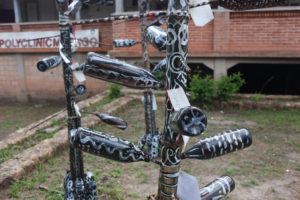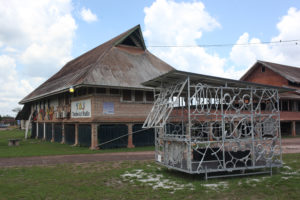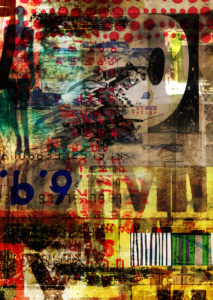
In this article art historian Vincent van Velzen writes about the arts in Moengo, the former mining city of Suriname, mainly populated by Maroons. He paints the context for and reviews the second Moengo Triennial, with the work of 23 international artists.
Tembe Fu Libi
Arts in Moengo, Suriname
In the east of Suriname, close to the border with French Guiana lies Moengo. This former mining city today could be considered the art capital of the country. This reputation owes the city to artist Marcel Pinas and his team that have been working on this goal for almost a decade. The ambition of a prosperous Moengo with a flourishing economy that is not based on raw materials – as bauxite previously provided for its short-lived prosperity – but on art, culture and tourism. Although gold mining is now very popular with both Surinamese youth and (partly illegal) Brazilian miners, this very polluting practice will not prove itself profitable in the long run. Moreso, the local population who mainly consists of people with a Maroon background of this out layer of the Amazon rainforest, is already suffering from deforestation by means of wood export and to create space for the mines and pollution related to the gold mining. Mercury poisoning occurs through the discharges into the river that is literally the live vein of this part of Surinam. It provides drinking water and food, as well as transport, communication and hygiene.
Heritage
Marcel Pinas, on the other hand, seeks a different future for Moengo. A future that is connected with culture in the broadest sense. This involves knowledge about the Maroon culture for which he founded the Kibii wi Koni Research Center. It has the objective to develop external interest for the culture, but through this knowledge also wants to build local appreciation for the people’s own habits, culture and background. Professor and former Tropeninstituut curator Alex van Stipriaan is one of the researchers involved. Unfortunately, in Surinam the Maroon culture still is associated with primitive backwardness, thus is considered subordinate and underdeveloped – simply because it is not perceived as ‘Modern’. This partially stems from the hierarchy imposed by the colonial project in which everything closer to Dutch and Western values was appreciated higher than the ‘primitive’ culture from the interior parts of the country. This for example caused the name of one of the main Maroon tribes to become used as a denigrating slur. Regrettable so, this structural deprivation has been internalized by many. The stigmatization is still going on, hence many Surinamese consider Moengo to be a residence for criminals, whereas they have often never been there personally. This is exactly the lack of real knowledge Pinas intends to change. He aims to create positive stereotypes on the one side, and awareness, self-esteem and pride on the other.
To do so, Pinas initiated the first museum of Moengo: Contemporary Art Museum Moengo (CAMM I), where he mainly shows his own work. In the related Recording Studio local teenagers are able to practice their musical skills and in upstairs’ Tembe Art Studio children from the region visit and learn about art; and find themselves and their culture represented in an institution. In addition, he manages to increasingly appropriate and transform the remains of Suralco – the subsidiary of the American mining company Alcoa that exploited Moengo and its environment in the hunt for bauxite – into locations where art can be shown. This resulted in the second part of the museum (CAMM II) that is located in the former staff hospital of Suralco at the current entrance of the city. The first wing was taken into use three years ago, during the opening of the first Moengo Triennial that was curated by Africanah-own Rob Perrée and prominent Dutch artist hailing from Moengo, Remy Jungerman. This exhibition included contributions by Tirzo Marta, Charl Landvreugd, Jakup Ferri, Iris Kensmil, Kurt Nahar, and Van Brummelen & de Haan, amongst many others.
Surinamese Art World
Every year Pinas and the Kibii Foundation team organize a festival that is based on a form of art. These include dance, theater and music. All artistic expressions that are of close interest to the inhabitants of Moengo and Suriname. Every third edition of the festival focuses on the visual arts, by means of the Moengo Triennial. In general the presence of the visual arts in the country is rather meager. The capital city Paramaribo is the home of a museum that merely focuses on history, and clearly suffers from a lack of government interest and funding. Contemporary art is shown at a few places, amongst which Sukru Oso (Sugar House) and most important Readytex Art Gallery. This gallery used to be housed on the second floor of a clothing and souvenir shop in the center of the Paramaribo. However, since several years it inhabits an impressive building in the historical center of city. Although fairly local and dependent on the private art market in a country of only 550,000 inhabitants, the initiative has been surviving and supporting the nation’s most prominent artist for 25 years now. Thanks to the investment and efforts of director Monique Nouh-Chaia Sookdew, with the support of these artists and her team, the endeavour is able to endure the circumstances. Nevertheless, the capital’s infrastructure leaves ample space for Pinas and Moengo to fill.
The second edition of the Moengo Triennial (and number six when it comes to the Moengo Festival) opened on August 17 (2018). For this edition, 23 artists from the Netherlands and abroad were invited to present their work at the second part of Contemporary Art Museum Moengo II (CAMM II). Some were previously present in Moengo during a residency. The residency program is for the greatest part made possible by the structural support of the Mondriaan Fund which each year allows two Dutch artists to travel to Moengo for a work period of three months. During their stay, the chosen residents teach in Moengo and the surrounding villages. As a final physical outcome of their time in Moengo they are meant to leave a work of art in the public space – as part of the continuously growing Moengo Art Park. Other contributing artists previously taught temporarily at the Nola Hatterman Academy (Paramaribo) as part of the exchange program with the Gerrit Rietveld Academy (GRA, Amsterdam) that ran from 2006 to 2014. This program also meant that a number of students could obtain their Fine Arts Bachelor degree from the GRA. These graduates of whom only some returned to their home country, also participated in the second Moengo Triennial. In addition, a number of international curators (from the Netherlands, French Guiana, Venezuela and Mexico) were asked to nominate two artists each; which also resulted in contributions to the exhibition.
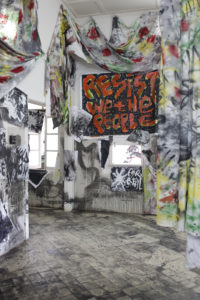
Marcel van den Berg, Talkin’ loud but sayin’ nothing, 2018
Tembe fu Libi
For the Tembe Fu Libi (Art for Life) theme of the Triennial, the different artists show art which was made in, with and about Moengo. Part of this includes collaborations between the invited artists and local artisans. The contributions mainly consisted of hand- and needlework. For example, Frank Mandersloot asked several local women to make a piece of clothing from a fabric he provided. The women wore the outcomes at the opening. Marcel van den Berg worked with local seamstresses to manufacture parts of his installation; and Yair Callender used a similar collaboration to achieve his textile-based work on show. Ton Zwerver found inspiration in the local head wraps (angisa) for parts of his installation – that as a whole aimed to function as a dream state environment.

Ton Zwerver, 4AM, The Nightwatchers, 2018
Raquel van Haver, Night in Moengo, 2018.
The question to involve the people of Moengo made Marjet Zwaans come up with a workshop to learn the local schoolchildren about coding in a playful manner; and inspired PJ Bruyniks and Vera Visser to translate the noise of Moengo into an sculptural audio-installation, while Neil Fortune transformed the former pharmacy space into a meeting point; to which he invited the citizens to drop by and bring something to put on show. It metaphorically meant that what the people of Moengo own, is worth to put in a museum. A strong gesture in line with the goals of Pinas. Artist Valerie van Leersum put the residents of the town in a spotlight. During here 2017 residency she asked several people which square meter was their favorite. She wrote stories about these places that were first published as columns in Parbode – a magazine distributed in Suriname. In the exhibition she presented the pictures of the different spaces concerned, juxtaposed with objects and plants relating to the local environment. Related, Coco van Duivenvoorde took the river as an inspiration for her photographs and related poem, while Moritz Ebinger used his research into gold mining as starting point for his installation. Raquel van Haver on her turn, visited Moengo for the first time ever, and (as she normally does too) took inspiration from the nightlife. She turned the glass liter Parbo beer bottles into her canvas, and painted them with Afaka-inspired signs (Afaka is a syllabary of 56 letters devised in 1910 for the Ndyuka language which is spoken in the Moengo region), after which she used the bottles to create a trio of wishing trees.
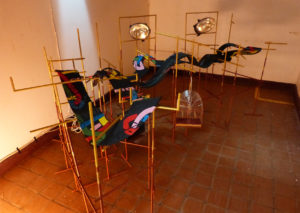
PJ Bruyniks & Vera Visser, FoMO Moengo, 2018

Coco van Duivenvoorde, Wataa, 2018

Moritz Ebinger, Operatie fu Gowtuman nanga den tu ati – X-RAY ROOM, 2018
Performance
Outside of the museum building, Feiko Beckers reminded the visitor that “if you do not cut the nails of your chicken feet, nobody will come for dinner”. He was struck by all the outdated signs around the town with messages that did not relate to any current reality anymore. So he made a new one, which was as relevant as quotidian.
Feiko Beckers, Something that is actually true, 2018
Dirk van Lieshout, with Firmin Sanou, Seraven Pinas, Furgill Raafenberg, Het Reisburo, 2018
Meanwhile, next to the sign Dirk van Lieshout continued with the project he had started during his residency (2018): a travel bureau made out of aluminum that contains different objects and information about Moengo. To construct this moveable office and its content, he worked together with the French Guianese artist Firmin Sanou – who also showed his own work in the exhibition. During the opening, the process of melting aluminum into new forms kept on going. This became a kind of performance, for the visitors to experience. Similarly, the three other French Guianese artists: Ozé Amiemba, Kaffé Bétian, and André Van Bree, led by artist-curator Patrick Lachaise were publicly shaping their wooden human-size sculptures of a native inhabitant and conquistador.
Annemarie Daniel, Kamba, zichtbaar onzichtbaar, 2018

Ravi Rajcoomar, Angry Youth, 2018
Several Surinamese artists were present too: former Nola Hatterman director Rinaldo Klas who was actually born in the building made several works on paper using local bauxite as his paint. Ravi Rajcoomar showed his work next to GRA graduates Razia Barsathie who used the masala herb for a self-portrait, Ruben Cabenda showed several of his animation video works and Annemarie Daniel presented an installation inspired by traditional Maroon scarifications. The young Moengo based artist Seraven Pinas created a small but gracious showcase of his paintings around a Nelson Mandela inspired sculpture on the top floor of the building.
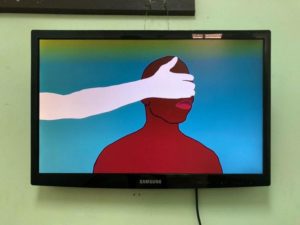
Ruben Cabenda, Die Ogen, 2018
Overall, this second rendition of the Moengo Triennale provided a fairly interesting view on the different sides of Moengo. In collaboration with many of its inhabitants and inspired by the (natural) surroundings, the different artists came to a collective statement that indicated an abundant wealth. Even though it sometimes might be hard to find on first sight, or have to be sought for during a three months residency, elaborate conversations with local residents and artisans, or a late night pub crawl, the exhibition clearly shows it is present; and definitely worth the travel.

